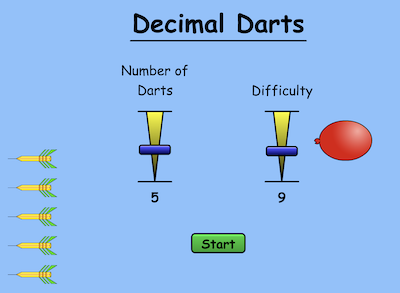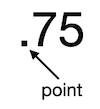
So point 65 is the same as 65/100 said the Mayor. That's between .6 and .7 and it would pop the balloon.
*For those of you that are reading this story, you might want to check out this website to learn more about decimals and place values. Otherwise it's time to play & enjoy Decimal Darts. Click on the image on the left.
Meanwhile, one of the fractions spotted the Burgerama and said it was time to eat. So off they went. Four-sixths

Joe: One of my hobbies is is to change all fractional numbers into a fraction with a denominator of 10, 100, 1000, etc. For example, to change 3/4 to such a fraction I immediately clone (multiply the numerator and denominator) 3/4 by 25 and presto, I have, 75/100. I like doing this except it gets awfully boring to have to keep on writing the slash 100 all the time. So being as clever as I am, I invented* a shortcut. Instead of writing 75/100, I write point 75. It looks like this:

23/100 looks like .23 while 3/100 looks like .03, and so on.
"I get it," said four-sixths. "So what would 3.5 be as a fraction? "If you have a number before the decimal point you treat it as a whole number. So 3 point 5 is 3 wholes and 5 tenths. (In decimal notation you don't reduce fractions.)

* John Napier is given
credit for starting to use a decimal point in the 17th
century.